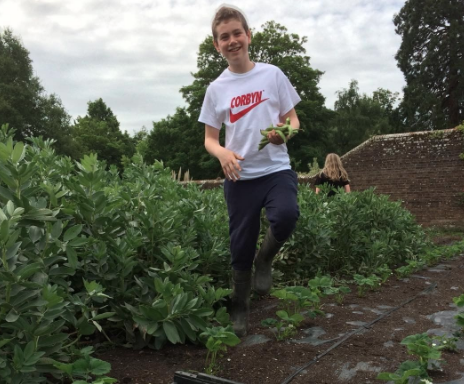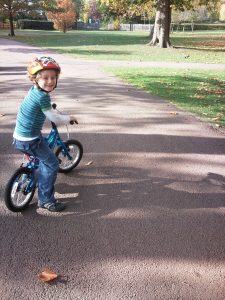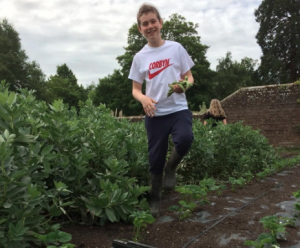Callum Grant, father of Luca Maestri age 13, writes about their Montessori journey.
——-
We never had to set aside special time to practice reading with Luca. No coaxing or bribing was required. He had no boring ‘reading books’ and no keywords to learn by heart. He just looked over my shoulder one day and started reading words out of the newspaper. Well that was easy I thought, feeling a little guilty at the total lack of effort involved.
It is events like this that gradually cement your commitment to Montessori. No leaps of faith or really difficult decisions have been involved.
I would like to illustrate this point by starting at the very beginning, but I can’t. It’s one of those family stories where none of the central characters can agree on the details. The simple truth is that Kate doesn’t remember how she heard about the open day at West Hampstead Children’s House. I can’t even explain why she went. There were plenty of nursery schools that were much closer to home; and we had no idea who or what Montessori was.
It may be an unsatisfactory way to begin, but it does illustrate a crucial point. It was a series of coincidences and lucky breaks that initially lead us to where we are now. The first family to have a child in Montessori from age two and a half; right through to the adolescent programme.
Kate is an artist, a visual person, and the way that the children’s house looked made a big impression. The beautiful, orderly, child-sized environment was a huge contrast with all the nurseries she had seen before. “A place for everything and everything in its place”. She reported back enthusiastically that each little table had a glass vase with a flower. I have to concede that at this point I wasn’t taking much notice, but my first visit to a Children’s House jolted me out of my complacency.
Experience told me that little children were noisy, and when you put lots of them together it was chaos. It therefore followed that nurseries were clamorous, grubby and disordered. Entering a neat room and seeing a dozen infants working busily was strange. I felt as if the sound was on mute. Contented humming was all I could hear.
We read that getting Luca into West Hampstead Children’s House would involve us demonstrating a commitment to the principles of Montessori. Kate and I are open to big ideas. If someone is saying that the way things generally work is wrong – we’re listening. I assumed that a hasty google would spoon out the information I needed to demonstrate ‘commitment’. Immediately something struck a chord. I discovered that Montessori prioritises the child’s needs and interests.
North London has more than its fair share of sharp-elbowed parents, determined to start competing for nursery school places before their children are even born. Some had warned that we were leaving it too late by waiting until he was actually the right age to start. However it was only reading about Montessori’s ideas that I had the first flicker of genuine enthusiasm. I thought about the contrasting zeal and intensity I had applied to my chosen interests and to ‘work’. What would it have been like if there was no distinction between the two?
Raising a Montessori child has answered this question. Gradually and effortlessly we have seen how the theory becomes practice. Extraordinary care and organisation make this happen. Towards the end of his time at the Children’s House Luca decided to plot the progress of the twenty teams, eight groups and sixty-four matches of the 2010 World Cup finals. He produced his own enormous wallchart with each team represented by tiny, painstakingly drawn national flags. All the children followed the tournament’s progress through a ritual of noting the changing positions of the meticulously blu-tacked scraps of paper. Each day the teachers delicately and conscientiously helped to preserve this labour of love. The Children’s House operated in a church hall and everything had to be tidied away to allow other events to take place at weekends and evenings. The dedication involved only became apparent when we tried to take the fragile wallchart home at the end of term. Before we’d even reached the car Slovakia, Cameroon and Switzerland had fallen off and were lost forever.
We did go and take a look at our local primary school when Luca was old enough for reception class. His birthday is in the summer, and he would have been one of the youngest, at a time when small differences in age can be important. The mixed age group in the Children’s House meant that this was never an issue. Montessori teachers observe, and let the child tell them when they are ready for the next step. We had both been certain that Luca would go to the local primary school. When the time came, we just couldn’t cut the Montessori experience short by not allowing him to complete the three to six cycle.
The decision to send Luca to Elementary wasn’t difficult either. By this stage our purported commitment was a reality. We were excited by what the Maria Montessori Institute told us about the differences between the Elementary programme and the Children’s House. In the same way that the Children’s House allowed Luca to follow his own developmental interests, in Elementary he followed his conscious interests. If Luca is in any way typical, an adult can’t dictate these interests.
Once a subject has sparked Luca’s imagination it becomes a passion; a prism through which everything around him is perceived. As long as he kept to his individual work plan and managed his time in Elementary, he was free to make his own explorations. This lead to in-depth, exhaustive research of, World War Two, Bali, typography, football, punk rock, Soviet communism and computing. He was able to work through his passions. They weren’t deemed less important than mathematics or language, it was understood that moving from one subject area to another added detail to the framework provided by the cosmic stories. He just had to ensure that he did all the work agreed in his plan. This encouraged him to take responsibility for his own actions.
The mixed age group continued to be of benefit. In Elementary Luca made important friendships with children who were older and younger. This might not have been possible in mainstream education. School was a consistent and comfortable place. However a cloud of uncertainty loomed on the horizon – secondary school.
I assumed that Luca would go to our local comprehensive school. It is comparatively well regarded and very large.. I knew that moving to such a huge school would be a big change. His teacher at Elementary was vastly experienced and we had gone from awestruck admiration of her astuteness to almost taking it for granted. Montessori Elementary education helps children to find ways to resolve conflicts and tests them with their peer group. It can be challenging and Luca would occasionally share problems or concerns with us. If mentioned to his teacher, she had a daunting ability to immediately get to the essence of the problem. The very next day she would help Luca to get back on track with a few judicious words or some other chess-like manoeuvre. In contrast, a teacher in a massive comprehensive school would have a fleeting appreciation of Luca’s character. Parent/teacher meetings at his Montessori schools had been edifying. The reassurance gained from speaking to a teacher who genuinely knows your child is priceless. The change of environment would also have been disappointing. A beautiful Arts & Crafts building in Hampstead had replaced the Children’s House that so inspired Kate at the beginning. The surroundings and atmosphere seemed perfect for learning, but I was resigned to what seemed like an inevitable change for Luca when he reached the age of eleven.
Yet again Kate was the instigator in finding a different way. Yet again we were very lucky. Around the time that Luca was old enough to go into Upper Elementary, Kate was chatting to Karen Pearce at the school summer fair. She was bemoaning the fact that Luca’s Montessori education would have to be cut short when he got to be eleven. “It’s funny you should say that” said Karen, and explained that the newly opened Montessori Place in Hove had ambitions to start a secondary school.
Kate was captivated by the idea that the secondary school would be ready in time for Luca to start. She found out everything she could about Montessori’s idea of an Erdkinder or earth school; where children live close to nature, eat fresh farm products and carry out practical work. Kate was convinced that keeping Luca in Montessori education had to be our goal. I, and most of the other parents she spoke to, had doubts. How could we be sure that the new school would be ready in time?
Kate managed to talk me into attending a presentation by Laurie Ewert-Crocker from the Hershey Adolescent Community in America. I felt the same excitement that first drew me to Montessori. I considered what an opportunity this kind of education would be for Luca, but my elation really came from imagining what it would have done for me. My own education wasn’t terrible, but when you feel a genuine envy for what is on offer to your child, it must be right. We have considered a few different options over the years, but only Montessori has made me feel this way.
We visited Rob, Paul and Karen in Hove a couple of times to discuss their plans for a secondary school. On our last visit they assured us that the Land School would be ready when Luca was twelve. We told them that we weren’t going to consider any other school. It wasn’t a difficult deal to strike. They were going to do all the work and all we had to do was trust that they could. We didn’t have to conjure this trust from nothing. We already felt that the Montessori education had delivered on its promises. At each stage of Luca’s schooling we had heard the theory and then seen it played out in practice. Kate always described it as magic. Luca worked, but it seemed effortless, because he enjoyed it. Karen and Paul had already been part of the story anyway. Karen had been head of schools in London and Paul actually taught Luca for a year in the Children’s House. Although when he was six Luca didn’t think ‘teacher’ was the appropriate terminology for Paul. He said, “Mr Pillai doesn’t teach, he just plays!”
Towards the end Upper Elementary became slightly overshadowed by parent’s attempts to ready their child for the secondary school of their choice. These are weighty decisions taken after much deliberation. Whilst all the existing school alternatives in London were shown due deference, there was an interesting reaction to our commitment to something new and untried. This was particularly true when Rob, Paul and Karen were still looking for a site. How could we commit to a Land School without land?
It seemed such a short time since Luca’s ‘playmate’ had gone off to start a new school on the south coast and so much had been accomplished already. Montessori parents from London were always made welcome in Hove. This was because the Montessori Place was the best advert for the Land School. Rob, Paul and Karen had been able to create a beautiful, inspiring school for children from one to twelve, and it was thriving. Even this achievement didn’t prepare us for what they did next.
We anticipated that the Land School would be in a big house with a few acres or a muddy corner of an existing farm with some ramshackle buildings for the adolescents to repair. When we were shown round the Easons Green site one rainy Sunday we couldn’t believe what we were seeing. It was perfect. Woodland, a walled garden, sports courts and existing buildings that could accommodate a whole Montessori community; this school was happening and once again I wished it were me that was going.
We have been lucky to keep our son in Montessori for such a long time. There are several points along the way where parents can feel compelled to move their child to a different school. Reception class and at eleven are the main ones. The fluctuation in numbers that this can cause did make us worry about the size of Luca’s peer group at times. It always worked out though. Children don’t need the huge group of classmates of exactly the same age that mainstream education makes us expect. Luca has always had school friends and the mixed age group has worked well for him. It is a shame that so many children leave at eleven and don’t have the opportunity to stay until the second plane of development has been completed. Luca was still very much an Elementary child at eleven. We struck lucky again and he was part of an unprecedented cohort whose parents decided they should stay to twelve. At twelve he was ready, in fact he was desperate, to leave. Elementary had given him a sense of authority over his education but he was now ready for something deeper and more authentic.
Before I became bound to the idea of the Land School I had been apprehensive about the responsibilities of raising an adolescent in London. Beyond the usual concerns about pollution and health, I worried that adolescents are easily distracted, and London is teeming with distractions. It is a city of advantage and choice, but what’s offered is sometimes only the opportunity to be a consumer. Adolescence can be tinged with impetuousness and narcissism and this isn’t necessarily the ideal culture to discourage that.
By the time the newly named Young People’s Community (YPC) opened Luca was showing all the signs of adolescence: Rapid growth, developing independence and a drive to enter adult society. He was leaving behind the innocent state of childhood and becoming attracted by the veto power of cynicism. Fresh air, good food, practical work and humane kindness seemed to be exactly what he needed. On the first day of term the Sussex countryside looked glorious in the September sunshine, the main building at Easons Green had been transformed and his old friend Paul was waiting to be his guide. I couldn’t imagine a better environment for Luca.
The seven adolescents quickly started to refer to themselves as the YPC. They understand and are proud that they are the pioneers. There has been a lot to set up and this has been the kind of proper work that was promised. Luca has been heavily involved in establishing IT and communications systems. Contributing to something he knows is real and collaborating with experts has been rewarding. It has strengthened his confidence and faith in himself. As someone who thinks he doesn’t like maths he is happy to work out the profit margin on an order of 150 cucumbers or the unit price of homemade granola supplied to a café in London.
Montessori talked about adolescence as a time of physical, emotional and intellectual turmoil. In the first term Luca really needed the guidance that Paul provided. Luca’s doubts and hesitations were sometimes betrayed by what appeared as cynical reluctance or resistance. Paul kept telling him, over again and in different ways, that kindness makes happiness. Slowly the trust necessary to believe in himself and his social community has begun to flower. It is easy to underestimate the importance of this kind of ‘work’.
When he arrived at the YPC Luca was delighted to discover a music room with instruments and recording equipment. This has become his new passion, the current in-depth, exhaustive research. A guitarist who was reluctant to practice has been transformed. To witness what a self-learning Montessori child can achieve, aided by a visiting expert is astonishing.
Expertly equalised and mastered digital dance music wasn’t quite what we anticipated coming from a farm school, but there has been plenty we did expect. Luca has never had pets or the opportunity to bond in any way with animals before. For the last term he has been responsible for letting the school’s small flock of ducks out each morning and putting them safely back inside at the end of the day. They were unruly at first but now he has them so well trained that they obediently make for home as soon as he appears in the late afternoon. Spring weather has made working outside more enjoyable – work like composting, digging or planting seeds is a good opportunity to chat and socialise.
The first really big project for the YPC has been turning an almost derelict stable into a fully functioning wood workshop. This was achieved within the first two terms. To an outside observer it seems incredible that they are responsible for this space; from virtually nothing to a functioning part of the school. The YPC seem to have taken it for granted that they could do this. Welcome to the new normal!
Before this all started, we could never have imagined where Luca would be at this stage in his education. Montessori has been a reliable guide and has told us what to expect, but nothing truly prepares you for the changes that you see in your child. The way Kate describes it really does sum it up – magic.




